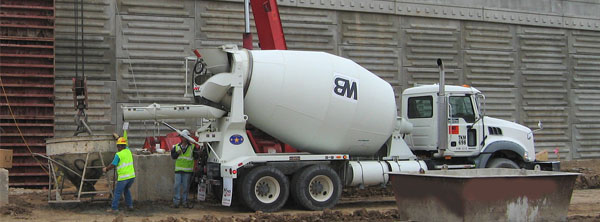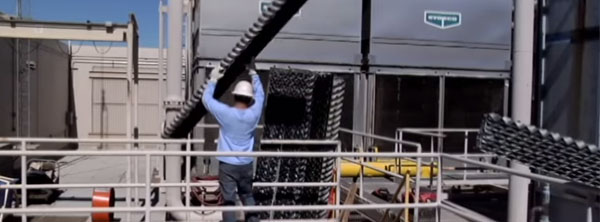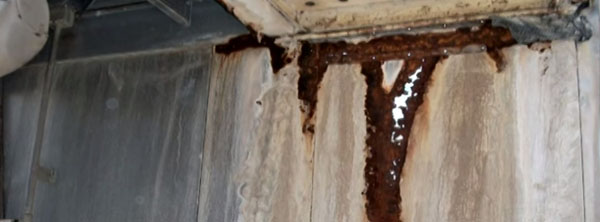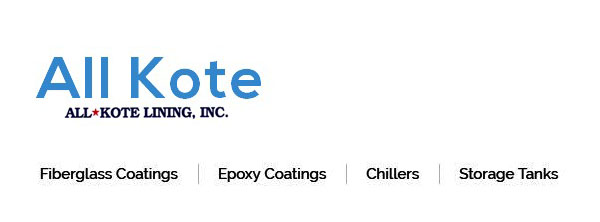Are you searching for “How Cooling Towers Operate“? If so this post is designed to help you understand what a cooling tower is, what it does, different types of cooling towers and more. Alle Kote Lining has a wealth of knowledge and experience with cooling tower repair, refurbishment, and maintenance. Cooling Towers are a critical component of our modern industrial and commercial world. How cooling towers operate is a fairly complex question. In this article we will explain a little about how they help keep our industrial equipment, warehouse, and even shopping centers cool and comfortable.
What Is A Cooling Tower?
The processes and machines of industry in addition to the machines dedicated to our own comfort and well-being, produce a tremendous amount of heat. If that heat is not continuously dissipated those processes or machines will not be able to continue to operate efficiently. Much like the heat from the motor in your car is transferred via a fluid to the radiator; cooling towers continuously transfer heat via a flowing volume of water from the air conditioning condenser or high heat equipment to the cooling tower area. Final heat rejection is always done through one or another type of heat rejection, but is also exhausted into the atmosphere.
Natural processes of evaporation are very effective heat transfer methods; however they are limited because of their total dependence on random winds and limited surface area. We’ve all experienced those super hot summer days where we are dying for a breeze. The first and most basic system of evaporation is air flow, which is a natural form of evaporation cooling. Before man had electricity we had hand held fans, which uses the same foundation concept that a cooling tower does to cause heat exchange and rejection.
How Do Cooling Towers Work?
They are high output heat rejection equipment used for cooling large commercial buildings, power plants or mechanical equipment in industrial applications. Water that has been heated by either an industrial process or an air conditioning condenser is passed through a cooling tower via a pump system. That water is then sprayed through nozzles onto pads of material called “fill”. As the water hits this fill material it is spread as wide as possible to maximize the air-water contact. The water is then pulled through the system via an electrical motorized fan.
Cooling towers work by extracting waste heat and exhausting it into the atmosphere through the cooling of a stream of water to a very lower temperature. Cooling towers are a type of hear rejection system that is know as “evaporative”. This is because they allow a small portion of the cooled water to evaporate into a flowing stream of air to cause significant cooling to the remaining stream of water. Using a hot water system heat and humidity is transferred to the air in the cooling tower. This raises the temperature of the air and the humidity to 100%, and then with the natural characteristic of hot air, it rises out of the cooling tower a bit like sweat cooling our skin. Significantly lower temperatures for the cooled water are possible with this evaporation heat rejection technology.
Types Of Cooling Towers
Cooling towers are produced in several types, and even numerous sizes depending on the specific application. Depending on the heat load different configurations are necessary, and certain sizes will be necessary given the requirements and geographical location. Knowing which type fits the users requirements is paramount. Different models have various advantages and limitations.
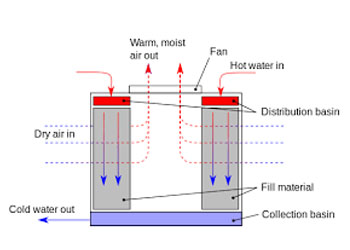
Crossflow Cooling Towers – With crossflow cooling towers the water flows down vertically through the fill material while the air flows horizontally across the flow of descending water. With this system the air is not required to pass through the distribution system which allows the distribution of by hot water to flowing simply using gravity from hot water basins mounted at the top of the cooling units right above the fill material.
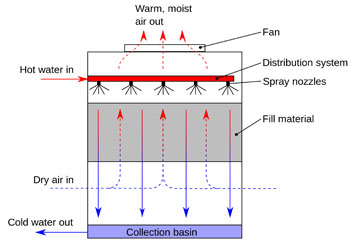
Counterflow Cooling Towers – These cooling towers are designed in a what that air flows directly up, in opposition to the direction of the water flow which is falling directly down onto the fill material. Due to the vertical air flow it’s clearly not possible to use the same open gravity fed system that crossflow cooling towers use. Instead counterflow cooling towers use pressurized spray systems to distribute the water in a spray on top of the fill material. Because air needs to be able to rise to make the system efficient the spray nozzles have to be spaced out appropriately. If this spacing isn’t correct either you will not have a sufficient amount of water on the fill material to maximize it’s potential, or you will restrict the air flow and again, cause the system to run less effectively.
Forced Draft versus Induced Draft – The biggest difference between these two cooling tower distinctions is where the air flow is being applied. With your forced draft tower types you’ll find that the air flow is being caused by blowers that are located at the base of the air inlet face. In contrast Induced draft cooling towers utilize a fan that is usually mounted at the top of the unit that pulls the air through the fill media area.
Performance Variables
Every cooling tower and it’s components are designed with a total system approach. They are engineered to work in union as an integrated system. This means they will perform more efficiently and will last longer. Here are some of the variables that are considered when trying to achieve maximum efficiency.

Driveshafts – Much like your vehicle, the driveshaft delivers power from the output of the motor and into a gear assembly. Due to the inherent moisture in these cooling towers the driveshafts must be constructed of high corrosion resistant materials. Due to the high RPMs experienced while operating cooling tower driveshafts can be balanced, and re-balanced. This is much like the balancing of tires on our motor vehicles. When a driveshaft or tire isn’t balanced it causes vibration and accelerates the degradation of the system.
HVAC Free Cooling – Simply stated HVAC free cooling is a design feature in cooling towers by which cool air from outside is simply taken into the system to save on energy costs. During certain seasons the air outside your facility is cool enough to work inside the cooling tower and doesn’t need to be processed before entering the cooling tower. Your cooling tower’s ability to do this is largely controlled by the designer’s choices during the development phase.
Fans – Clearly when you are trying to achieve cooling through the passing of air through water saturated fill materials air flow is elementary. Cooling tower fans aren’t used in every design, but some are totally reliant on their help to move air through the fill material. Just like the driveshafts these fans must be made from corrosive resistant materials to cope with the humid environment they must perform in.
Variable Flow – Not all days are made equal, or are equally as hot. For this reason there are units that are variable flow. When the cooling tower isn’t under peak demand the air flow can be reduced and the system can consume less energy. It’s a great way to still get the required cooling but not have to over use your resources.
Nozzles – Counterflow systems require utilize a pressurized, closed pipe system to deliver water to spray nozzles. These nozzles then spray water onto the fill material. In crossflow cooling tower systems the hot water is elevated to hot water basins above the fill material. It is then gravity fed through the distribution basin through nozzles onto the fill material.
Drift eliminators – Much like catalytic converter controls the unused gasoline in our exhaust a drift eliminator controls the unused water droplets exiting the cooling tower. Water droplets are filtered out of the exhaust system and recirculated back into the cooling tower system. Doing this cuts down on the water the cooling tower needs to consume.
Fill material – Probably the most important element in the cooling tower is the fill material. It’s designed to maximize the distribution of water for maximum contact with the airflow. Not just how much air and water come into contact, but in what duration they are mixed defines much of the efficiency of the cooling tower. There are two basic categories of fill material, splash and film.
Built And Delivered or Built On Site
Cooling towers are generally large assembles. Factory-Assembled cooling towers are built in factories and then transported via over-sized 18 wheeler transports. Field-erected cooling towers are built at the site.
Field-erected cooling towers – These towers are constructed at the site they are needed. They are generally large cooling towers which are produced in smaller, transportable sections. These sections are numbered so the final assembly can be done on site. Generally the manufacture will provide supervision and labor for the final assembly. These cooling towers can be made to utilize either counterflow or crossflow air management.
Factory-assembled towers – Depending on the size of the factory-assembled tower it can either be shipped as one large unit or in a number of smaller sections. Large multi-cell units will need to be shipped in sections and assembled at the intended site of use. These towers are also known as “FAP” (factory-assembled product) or “packaged” towers. These can also be configured with counterflow or crossflow air management.

